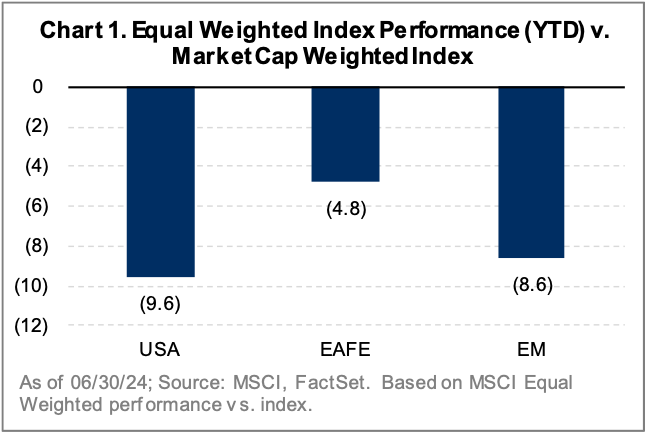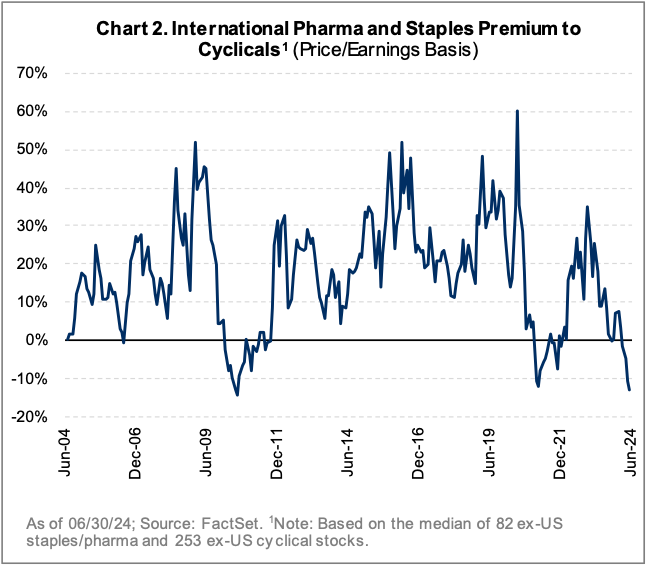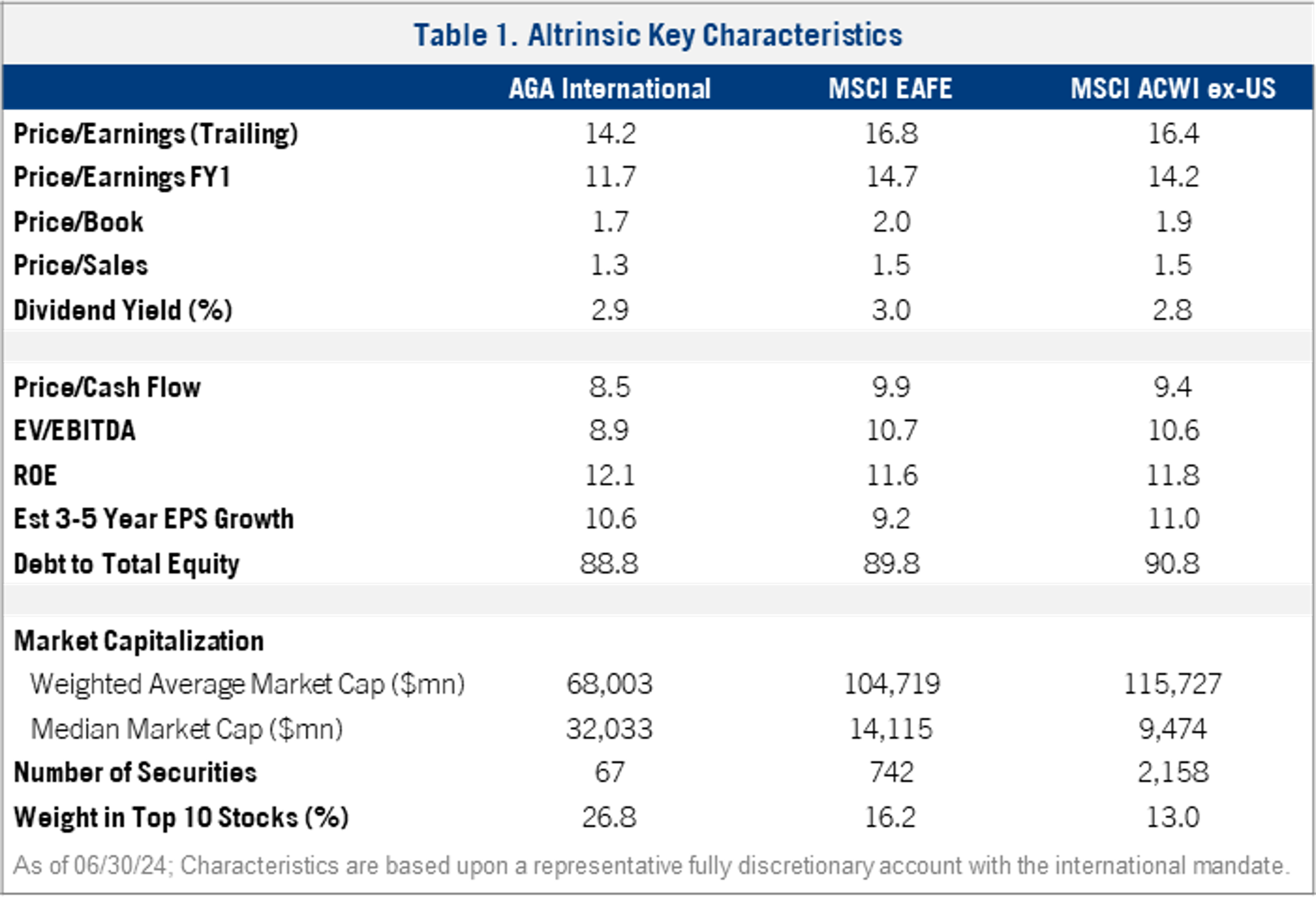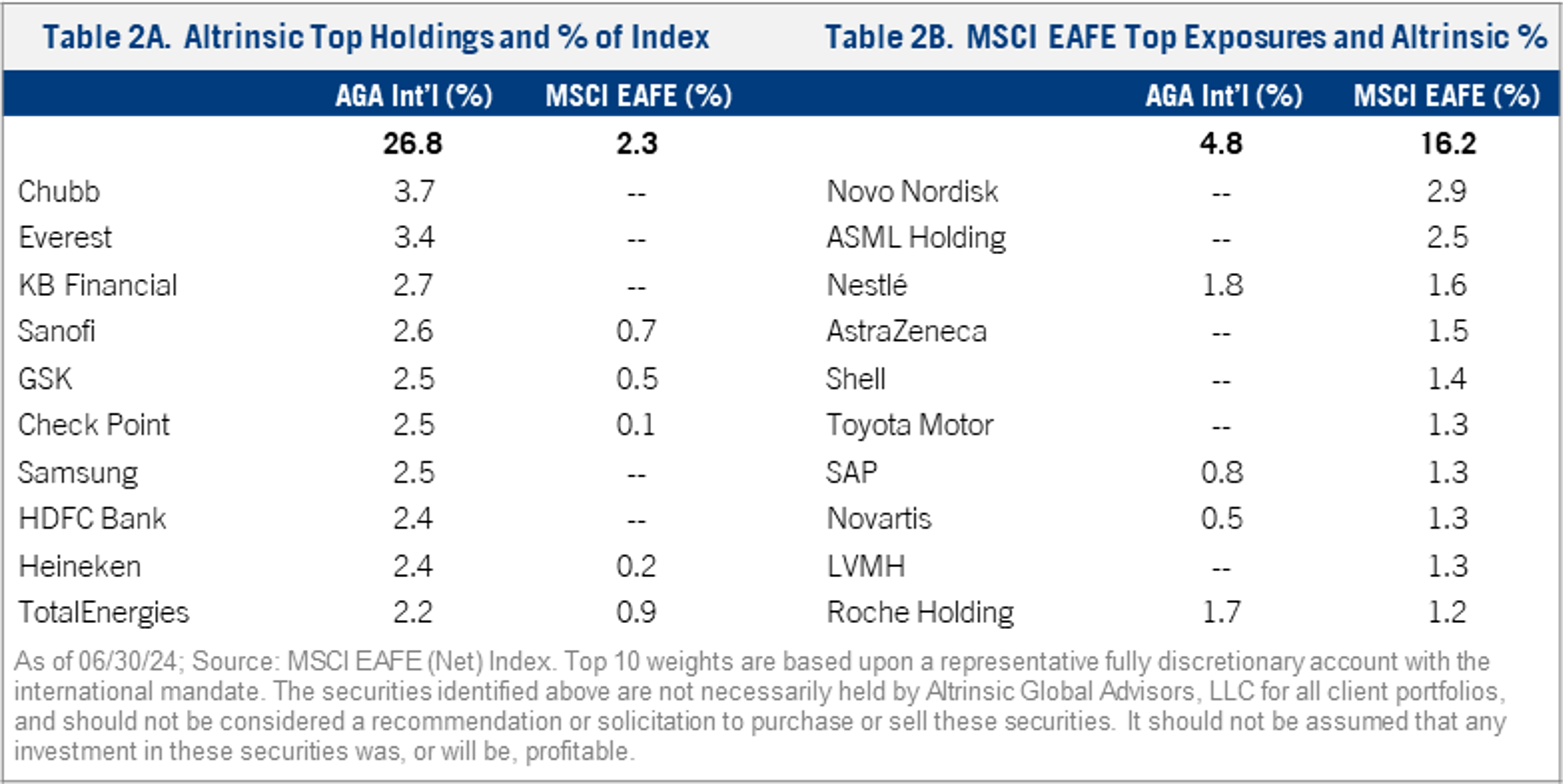Dear Investor,
The Altrinsic International Equity Portfolio declined 2.3% gross of fees (-2.5% net) during the second quarter, underperforming the 0.4% decline in the MSCI EAFE Index, as measured in US dollars.i It has been a difficult start to the year; many of our investments are operating better than their share prices would indicate. There were some setbacks, but overwhelmingly, our companies are doing quite well. They are just not capturing the enthusiasm and flows surrounding a small number of highly-priced AI and GLP-1-themed growth stocks.
We are believers in the AI renaissance and its long-term potential to drive productivity enhancements, but we also believe embedded expectations are excessive. The “obvious” has seldom been more crowded, and this is reflected in high valuations and expectations. We share Jeff Bezos’ view that AI is a horizontal technology that will benefit a wide range of companies. Observing value creation involving other transformative innovations – electricity, light bulbs, railroads, and the internet, to name a few – reveals that the greatest returns were realized outside of the companies that garnered the early excitement. Similar exuberance is evident in Novo Nordisk, a Danish pharmaceutical company producing GLP-1 weight loss drugs Wegovy and Ozempic. Early enthusiasm around those drugs has driven Novo’s market cap to almost $600B, greater than the GDP of Denmark, its country of domicile.
While the prospects for AI can be a catalyst for meaningful change for both companies and industries, prevailing conditions remind us of other episodes characterized by excess, including Japan (1989), the internet bubble (2000), and the run-up to the Great Financial Crisis (2007). During the latter two, our relative performance lagged as we avoided hyped stocks, but the subsequent episode was marked by significant outperformance. It may seem obvious to follow the crowd amidst the AI enthusiasm, especially given the compelling narrative, but as Joseph Schumpeter said, “Nothing is so treacherous as the obvious.”
But for now, the market has voted that a few US large-cap technology stocks, along with ASML and TSMC, are the winners. These are great companies, but consider the following:
- Five new economy stocks (Nvidia, Microsoft, Amazon, Alphabet, and Meta) added $4 trillion in market cap this year alone, with approximately $2 trillion coming from Nvidia alone. According to Deutsche Bank, as recently as October 2022, Nvidia was the 18th largest company in the S&P 500, worth less than $300 billion.¹ In 20 short months, it overtook Microsoft as the world’s most valuable company. This amount of market cap expansion is unprecedented; beware the law of large numbers.
- According to a recent Sequoia Capital estimate, some $50 billion has been invested in Nvidia’s chips since the boom began, but generative AI startups have only generated $3 billion in sales.² Much is being wagered on the future.
- Based on a recent US Census Bureau survey, fewer than 7% of US companies plan to utilize AI in the next six months, unchanged from the start of the year.³ There are some obvious tasks in customer service and health care that will benefit from AI, but growth of this type relies on new, currently unknown tasks or a surge in productivity. This is possible in the long term but unlikely in the near term.
- AI’s progress is constrained by its enormous energy requirements. Expanding electricity grid capacity is a lengthy and cumbersome undertaking held back by regulatory reviews, construction constraints, and environmental concerns.
The current surge has all the hallmarks of inelastic supply meeting surging demand. However, enormous investment will ultimately boost supply, while demand could prove more moderate and cyclical than currently thought. History is riddled with examples of great ideas that simply went too far, sometimes sowing the seeds of their own demise as disruptive new entrants arrived or valuations reached levels unsupported by underlying fundamentals. We believe AI is transformative, overhyped in the short term, and perhaps underhyped in the long term, with the eventual winners being different from those perceived as obvious today. Our investment philosophy and process – consistent since inception in 2000 – leads us elsewhere.
Performance Review
Broad index performance implies markets shrugged off rising geopolitical uncertainty and weakening economic data – but is this true? During the quarter, the MSCI EAFE Equal Weighted Index was actually down 2.0% (USD basis), and nearly a quarter of all EAFE stocks declined over 10%. As shown in Chart 1, the average stock in the US, EAFE, and Emerging Market indices has underperformed its own index by staggering amounts this year. Essentially, the small subset of large-cap growth companies, often GLP-1 or AI-themed, flattered the broad indices.

The Altrinsic International Equity portfolio’s negative relative performance was largely the result of investments in health care (not owning Novo Nordisk, weakness in Medtronic and GSK), consumer staples (Diageo, Pernod), and industrials (Kubota, Daimler Truck).
Within health care, obesity drugs continued to grab investor attention. Similar to other sectors, companies with growth saw their multiples expand, while slower growth companies saw multiples contract. Our relative performance was held back by device maker Medtronic and London-based pharmaceutical company GSK. Medtronic reported a solid end to its fiscal year, but the market continues to doubt the sustainability of its growth despite management commentary to the contrary. Poor past execution and some competitive product categories have contributed to this feeling. We believe the pieces are in place for solid top-line and operating profit growth that is not reflected in the equity valuation. GSK was pressured, as a judge in Delaware ruled that the Zantac case (ulcer drug accused of causing cancer) could proceed to trial. The market was expecting a dismissal, similar to a previous verdict. A trial means that the Zantac overhang will remain, but we have a high degree of confidence that their liability will be substantially less than what is reflected in the current price.
Consumer staples shares were pressured as they cycled through post-COVID volume and price volatility. Spirits companies, including Diageo and Pernod Ricard, have yet to show signs of a volume rebound as inventories are drawn down. With a 20-year track record of preCOVID volume and price growth, we expect growth to return as Western consumers retain a preference for spirits over beer and wine. From a broader perspective, a significant valuation gap has developed between more cyclical segments of the market and the least cyclical, with the latter at a historically high discount (Chart 2).

Within industrials, Daimler Truck shares declined on concerns about a slowdown in European large truck demand. After being spun out fewer than three years ago, the company has done a solid job improving its manufacturing footprint and product quality; the valuation today gives little credit for the ongoing opportunity to improve margins. Kubota shares are suffering from tepid demand for tractors in the US. In response, the company is taking steps to improve efficiency and expand in Asian markets where machinery penetration is low.
Investment Activity
As is frequently the case during periods of concentrated enthusiasm, we are finding value beneath the headlines and hype. As such, it is not surprising that investment activity picked up; we initiated four positions, including Aon (insurance brokerage), Banorte (Mexican financial services), Bank of Ireland (banking), and Yamaha Motors (Japanese marine and motor equipment), and sold two positions (Tokio Marine, BBVA).
We reinitiated a position in Aon after a period of underperformance. The company will continue to benefit from the rising demand for risk management and health care solutions in an increasingly complex and risky world and should capture further market share given its global expertise and attractive data franchise. Mexican-based Banorte generates high returns and cash flow, which should continue to compound as credit penetration in Mexico accelerates. Yamaha Motor, a first-time purchase, offers leading boat engine and emerging markets motorcycle franchises. We believe the company’s impressive turnaround, including rightsizing its developed markets motorcycle manufacturing function and improving its price discipline, is not reflected in its current valuation. Bank of Ireland went from being a bailed-out bank struggling with large credit losses to a well-capitalized bank that should be able to take advantage of a vastly improved competitive backdrop, a more supportive interest rate environment, and improving cross-sell initiatives. These opportunities are not reflected in the discounted valuation.
We sold BBVA and Tokio Marine in the quarter. Spanish bank BBVA has executed well, but we sold as the stock neared our intrinsic value despite announcing a controversial acquisition of Spanish peer Sabadell. Tokio Marine, a Japanese insurance company, outperformed our expectations over the last several years, significantly boosting its margins and ROE. Recently, the company announced plans to materially reduce cross-shareholdings, unlocking latent value. The resulting rally pushed the shares above our intrinsic value determination, leading us to sell the position.
Positioning and Outlook
Our pursuit of value beyond the popular and crowded stocks in the market has led to a portfolio that is meaningfully undervalued by almost any metric (Table 1). Additionally, the average discount to estimates of base case intrinsic value for our portfolio is roughly 20%. Perhaps more importantly, discounts to bull case valuations relative to bear case scenarios reflect a favorable asymmetric skew and substantial embedded value.

Not surprisingly, our positioning is also quite different from the broad indices. As seen in Tables 2A/2B, we have minimal exposure to the MSCI EAFE Index’s ten largest constituents. Additionally, our ten largest investments represent only 2.3% of the index and include a range of attractively valued companies with solid and/or improving fundamentals. We certainly feel the pressure that coincides with underperformance, but our confidence tends to be greatest during circumstances and conditions that match the prevailing situation.

Summary
Headline index performance, dominated by a few large-cap growth stocks, is not indicative of the broader market returns. As we have seen in previous episodes of market exuberance, trees do not grow to the sky, and stocks do not go up forever. While there have been some disappointments, companies in our portfolio are performing better operationally than their stock prices would indicate. We are confident that the value being generated will be properly recognized.
Please contact us if you would like to discuss these or other matters in detail. Thank you for your interest in Altrinsic.
Sincerely,
John Hock
John DeVita
Rich McCormick





